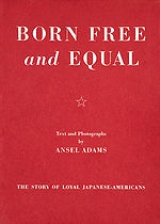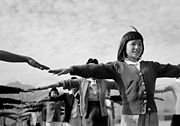
Born Free and Equal
Encyclopedia

Ansel Adams
Ansel Easton Adams was an American photographer and environmentalist, best known for his black-and-white photographs of the American West, especially in Yosemite National Park....
containing photographs from his 1943–4 visit to the internment camp then named Manzanar War Relocation Center
Manzanar
Manzanar is most widely known as the site of one of ten camps where over 110,000 Japanese Americans were imprisoned during World War II. Located at the foot of the Sierra Nevada in California's Owens Valley between the towns of Lone Pine to the south and Independence to the north, it is...
in Owens Valley
Owens Valley
Owens Valley is the arid valley of the Owens River in eastern California in the United States, to the east of the Sierra Nevada and west of the White Mountains and Inyo Mountains on the west edge of the Great Basin section...
, Inyo County, California
Inyo County, California
-National protected areas:* Death Valley National Park * Inyo National Forest * Manzanar National Historic Site-Major highways:* U.S. Route 6* U.S. Route 395* State Route 127* State Route 136* State Route 168* State Route 178...
. The book was published in 1944 by U.S. Camera in New York
New York City
New York is the most populous city in the United States and the center of the New York Metropolitan Area, one of the most populous metropolitan areas in the world. New York exerts a significant impact upon global commerce, finance, media, art, fashion, research, technology, education, and...
.
In the summer of 1943, Adams was invited by his friend, newly-appointed camp director Ralph Merritt, to photograph life at the camp. The project and the accompanying book and exhibition at the MoMA
Moma
Moma may refer to:* Moma , an owlet moth genus* Moma Airport, a Russian public airport* Moma District, Nampula, Mozambique* Moma River, a right tributary of the Indigirka River* Google Moma, the Google corporate intranet...
created a significant amount of controversy, partly owing to the subject matter. World War II
World War II
World War II, or the Second World War , was a global conflict lasting from 1939 to 1945, involving most of the world's nations—including all of the great powers—eventually forming two opposing military alliances: the Allies and the Axis...
was still being fought and the animosity against Americans of Japanese descent was high, especially on the West Coast.
Adams was not the only photographer to take pictures in Manzanar. Before him, Dorothea Lange
Dorothea Lange
Dorothea Lange was an influential American documentary photographer and photojournalist, best known for her Depression-era work for the Farm Security Administration...
had visited all eleven Japanese-American internment camps while a staff photographer for the War Relocation Authority
War Relocation Authority
The War Relocation Authority was a United States government agency established to handle internment of Japanese-, German-, and Italian-Americans during World War II...
. During Lange's visit in 1942, the camp was a less organized state and Lange was driven to portrait the injustice of the relocation project, leading to a harsher and less optimistic portrayal of camp life than Adams's. The third photographer was internee Toyo Miyatake
Toyo Miyatake
Tōyō Miyatake was a Japanese American photographer, best known for his photographs documenting the Japanese American people and the Japanese American internment at Manzanar during WWII.- Life :...
, previously a studio photographer in Los Angeles
Los Ángeles
Los Ángeles is the capital of the province of Biobío, in the commune of the same name, in Region VIII , in the center-south of Chile. It is located between the Laja and Biobío rivers. The population is 123,445 inhabitants...
. Miyatake initially took photos with an improvised camera fashioned from parts he smuggled into the camp. His activity was discovered after nine months, but Merritt supported the endeavor and allowed him to have his stored studio equipment shipped to the camp and continue the project (initially a camp guard had to release the shutter for him after Miyatake had positioned the camera). Miyatake and Adams met and befriended each other at the camp, while Lange's and Adams's visits did not overlap.
Adams's goal in the project was twofold: to stress the good American citizenship of the internees, as conveyed in the subtitle of the book, "The Story of Loyal Japanese-Americans"; and to show their ability to cope with the situation:
The purpose of my work was to show how these people, suffering under a great injustice, and loss of property, businesses and professions, had overcome the sense of defeat and dispair [sic] by building for themselves a vital community in an arid (but magnificent) environment…All in all, I think this Manzanar Collection is an important historical document, and I trust it can be put to good use. (Ansel Adams, 1965 http://memory.loc.gov/ammem/collections/anseladams/index.html.)
External links
- Exhibit of Manzanar photographs at the U.S. Library of Congress.
- Digitalized full text edition at the U.S. Library of Congress.

